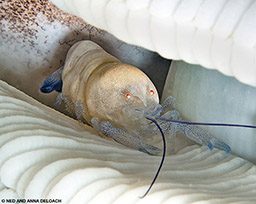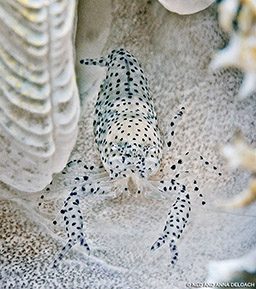
For 20 minutes my camera lens has been trained on a blue antenna the size of a cat’s whisker. It’s all I can see of a rarely seen shrimp that lives exclusively inside the gills of giant clams (Tridacna gigas), the largest bivalves on Earth. The one-inch shrimp, as white as the milky tissue of the clam it inhabits, wasn’t easy to find. Yan, my friend and dive guide, spent the week looking inside every clam we passed, and this is the first shrimp he found. So I am happy to remain right where I am until the air in my tank runs low or I finally get a shot of an animal I’ve been tracking for years.
By Raja Ampat standards the clam I’m kneeling next to isn’t large, maybe 20 inches at most — nothing like the colossus I was introduced to a decade earlier by liveaboard cruise director and diving pioneer Larry Smith.
It was our first trip to that region of Indonesia, and Larry, always full of himself, kept carrying on about a gigantic clam he had recently discovered. His unrequited enthusiasm got to the point that guests lounging in the salon one evening began referring to the object of his infatuation as “Larry’s Giant Clam.” This was just the sort of thing Larry loved. Disappearing into his cabin he returned waving a tattered field guide. He tossed it on the table and flipped through the pages until a series of bivalve images appeared. Leaning myopically close to the page, Larry read triumphantly, “maximum length 4½ feet.”

“Dagnabbit, that’s nothing — my clam will beat that hands down,” he added in his singsong East Texas drawl. And from that moment he was bewitched with the idea that his clam would set a new world record. Who could resist joining in such fun? Everyone aboard decided to become part of the quest to measure Larry’s Giant Clam for science, posterity and interplanetary acclaim.
So the next morning we backtracked to the lagoon where Larry had found his clam. And sure enough there it sat, upright and solitary, on a shallow white-sand apron that spilled seaward from a coral thicket. At first sight we were taken aback by the clam’s huge size. No one doubted Larry any more as we swam reverently around a pair of shells the size of a bathtub. Eventually we inched forward and one by one estimated its length with our arms spread. Later, over cocktails, we collectively arrived at 4½ to 5 feet.
While reprovisioning in Sorong for the second part of our trip, the steward purchased a measuring tape at the hardware store. Back at the lagoon we bailed out of our skiff, confident of a new world record. The clam was of course right where we left it, as regal as we remembered and waiting to be crowned king of clams. But measure as we might, all we could muster was 50 inches, and even that length was debatable. After all our starry-eyed anticipation there was no record and no glory, but to this day none of us has seen a clam bigger than Larry’s.
The hidden shrimp still isn’t budging, so my thoughts drift again to Larry’s Giant Clam. This time I try to calculate how long it must take for a clam to grow so massive: A hundred years? Maybe more, I’m guessing. By filtering food through their gills and farming symbiotic algae in their meaty mantles, giant clams can grow two inches a year for the first part of their long lives. Judging by this standard, the 20-inch youngster I’m keeping company must have settled here about a decade ago from the open ocean as a wafer-thin larva no bigger than a grain of sand.

While I’m tabulating clam math, the shrimp bolts into the open, moving faster than expected. I snap a shot as it disappears behind the gill folds. Glancing down, my camera display shows a fuzzy tail shot. Before I can chastise myself for allowing my mind to wander, the shrimp reappears, making the first of several passes over a white, sun-bright background before disappearing for good. I straighten up, snowblind and blinking. Yan, patiently hovering off to my left, gives a thumbs up.
Later, my downloaded images reveal that somehow I photographed not only the brawny female but also the smaller male. With this unexpected success, Yan and I become as quixotic about photographing clam shrimp as Larry had been about his giant clam. The next afternoon we locate a second shrimp species living inside the smaller, closely related giant clam.
This blue-speckled beauty is a dream to work with, repeatedly posing as if it wants its portrait taken. The other critter hunters aboard are now into the game, but a dozen eyes inspecting 10 dozen clams over the remainder of the trip turn up nary another shrimp.
Explore More
© Alert Diver — Q4 Fall 2016